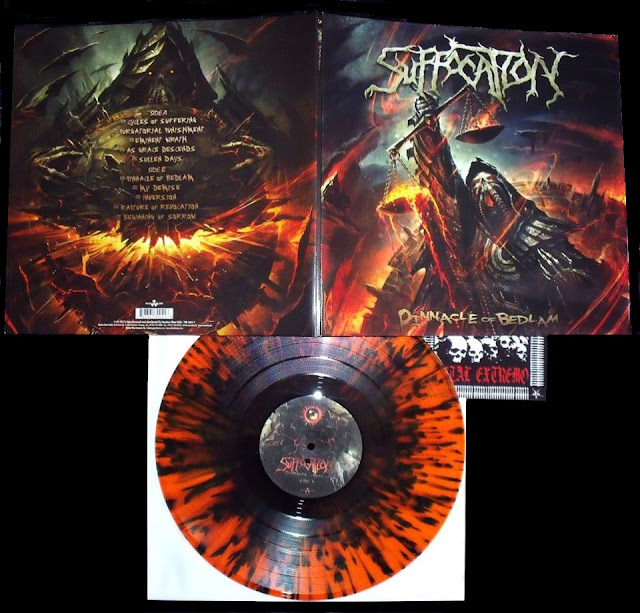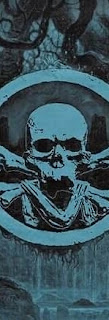Brujeria alumni include Fear Factory guitarist Dino Cazares and drummer Raymond Herrera, as well as Billy Gould, Nicholas Barker, Jeff Walker and Shane Embury. They perform under pseudonyms and portray themselves as a Latino band consisting of drug lords, concealing their identities due to being wanted by the FBI. In videos and photographs of the band, they are shown wearing bandanas, balaclavas, serapes, and are often shown wielding machetes.
2. Leyes narcos 01:09
3. Sacrificio 01:16
4. Santa Lucía 00:43
5. Matando güeros 02:24
6. Seis seis seis 01:19
7. Cruza la frontera 01:44
8. Greñudos locos 01:27
9. Chingo de mecos 01:16
10. Narcos-satánicos 01:50
11. Desperado 02:41
12. Culeros 00:51
13. Misas negras (Sacrificio III) 01:20
14. Chinga tu madre 03:11
15. Verga del brujo / Están chingados 03:43
16. Molestando niños muertos 02:57
17. Machetazos (Sacrificio II) 01:27
18. Castigo del brujo 01:44
19. Cristo de la roca 01:12
- Juan Brujo: Vocals
- Pinche Peach: Samples, Vocals (additional)
- Asesino: Guitars
- Hongo: Guitars, bass
- Güero sin Fe: Bass
- Fantasma: Bass, vocals
- Greñudo: Drums
- Jr. Hocicon: "Director diabólico".
"Güero" is a Mexican slang term for a pale-skinned or blonde-haired person, specifically used as a slur for US citizens of white/caucasian race.
Track 16 to 19 are remastered tracks off the "Machetazos" single.
The official line-up for the album credits Jr. Hocicon (Jello Biafra) as "Director diabolico" which means "Diabolic director"; it is implied that he was either the producer or exectutive producer for the album.
"Matando Güeros" is one of the songs to the "Gummo" soundtrack.
Upon the album's release there were many censoring issues with some stores in the U.S. and Europe due to its shocking content and graphic front cover. Roadrunner released a censored version with the cover showing just the name of the band and album title on a black background, although the original cover can be found in the inside booklet.
The decapitated head shown on the album cover became a well-known gimmick for the band, which they used as a mascot named "Coco Loco" (meaning "Crazy Head") and was widely featured in t-shirts, flyers and mech associated with Brujeria.
1993. La historia que siempre se manejó de la macabra fotografía de este personaje y lo que se empezaba a comentar entre la gente, apuntaba a que un pobre desconocido había sido secuestrado, asesinado, quemado y descuartizado por una enigmática banda que radicaba en la frontera (de la que no se sabía casi nada. Eran los 90's y el acceso a internet para conocer algo era bastante limitado, no como hoy día) que tocaban Deathgrind Metal mientras hacían rituales de santería negra y que decidieron tomarle fotos a su cabeza decapitada y ponerla como trofeo para la portada de su disco larga duración, lo cual se pasaba de boca en boca alimentando la leyenda día a día.
Todo esto no era tan conocido más que en el mundo metalero underground aunque ya había alarmado a algunas gentes y autoridades hasta que un día, fue lanzado un reportaje dentro del noticiero "Ocurrió Así", donde se investigaba la desaparición de un tal Mario Ríos y de su mujer, Alma Ruíz y dónde se menciona que la cabeza que aparecía en la portada "del disco de un grupo llamado Brujería" podría ser la del Mario Ríos que andaban buscando, vinculando a la banda a su desaparición, y esto hizo que se detonara más lo oscuro detrás de la misteriosa banda y su portada, y por ende, se regara como pólvora por todo el mundo.
En fin, habían creado con éxito un monstruo bastante oscuro que se iba alimentando más y más. Una verdadera Creepypasta noventera con wevos y chingona, que si llegó a hacer que la gente se cagara, no como lo que se presenta hoy día...
Todo eso fue una leyenda creada de muchos elementos. La verdadera historia de cómo esa foto llegó a ser la portada del Matando Güeros, emitida por el mismo Juan Brujo, dicta que un día, entró a una liquor store y lo primero que vio fue una Revista Alarma (DATO: siempre se ha pensado que fue una ''Alarma'', pero en realidad era otra publicación amarillista similar de nombre "Revista Peligro!" donde originalmente la historia era acerca de un tipo borracho que cayó en las vías de tren y murió decapitado) en dónde venía la foto que todos conocemos, y al quedar impactado también con la brutal imagen, el Brujo se comunicó con la editorial para que le vendieran el original, lo cual al principio se negaron, hasta que negoció ofreciendo U$300 satánicos y de inmediato se la enviaron vía FedEx y de ahí para la legendaria portada de uno de los discos más icónicos, crudos, brutales y únicos de Deathgrind Metal que han existido en la historia de la humanidad.
Dato extra: De ahí Juan Brujo aprendió más español, de leer Alarmas.
MATANDO GÜEROS POR VIDA. NO VA A HABER OTRO, NO ACEPTAN IMITACIONES.










































